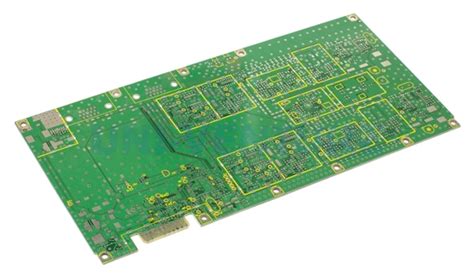Leading Automotive PCB Manufacturers Driving Innovation in Technology

Key Takeaways
As the automotive industry evolves, the significance of PCB assembly processes becomes increasingly apparent. Automotive PCBs, or printed circuit boards, are integral to the modern vehicle, enabling advanced electronic systems that enhance performance and safety. Leading automotive PCB manufacturers are consistently innovating to meet the demands of a more connected and automated driving experience. They are investing in cutting-edge technologies that improve signal integrity, reduce power consumption, and facilitate complex functionalities in a compact form factor. Through the effective use of PCBA techniques, these manufacturers ensure that every component is optimized for durability and reliability under various operating conditions. Not only do these innovative solutions amplify vehicle capabilities, but they also play a crucial role in safety features such as electronic stability control and advanced driver-assistance systems (ADAS). The collaboration between automakers and these manufacturers exemplifies the drive towards a smarter automotive future, setting standards that push the boundaries of technology while addressing environmental considerations inherent in manufacturing processes. As we look to the future, these advancements in automotive PCB design will continue to be pivotal in shaping how vehicles operate on our roads.
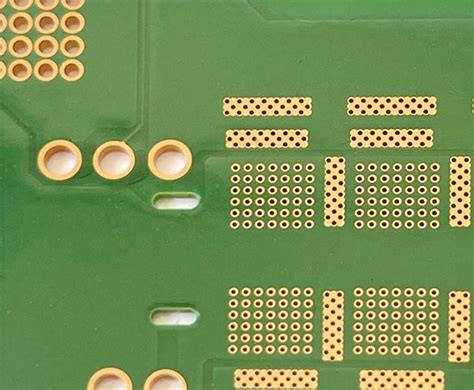
The Evolution of Automotive PCBs: A Historical Perspective
The development of automotive PCBs has undergone significant transformation since their inception in the automotive industry. Initially, pcb assembly involved simple circuits that primarily supported basic functionalities such as lighting and audio systems. As vehicles evolved into sophisticated machines, so did the needs for more intricate and reliable electronics. PCBA technology began to embrace multilayer circuits and complex designs to accommodate the growing demand for safety features, infotainment systems, and navigation tools.
By the late 20th century, advancements in materials and manufacturing processes allowed manufacturers to produce more durable and versatile PCBs capable of withstanding harsh thermal and mechanical conditions typical in automotive environments. The incorporation of automated assembly techniques further enhanced production efficiency, paving the way for high-density designs that improved performance without compromising safety.
The table below illustrates the timeline of significant milestones in automotive PCB evolution:
| Year | Milestone | Description |
|---|---|---|
| 1960s | Introduction of Basic PCBs | Initial use for simple electronic functions within vehicles. |
| 1980s | Multilayer PCB Development | Enabled more complex functionalities such as advanced audio systems. |
| 1990s | Rise of Surface Mount Technology (SMT) | Improved miniaturization and reliability in pcba processes. |
| 2000s | Integration of Automotive Standards (ISO) | Enhanced safety features and compliance within automotive electronics. |
As we look towards modern applications, it is clear that today’s automotive PCBs are integral to a vehicle’s overall performance, directly impacting features like adaptive cruise control, parking assistance, and collision avoidance systems. This historical perspective highlights not only the journey but also primes us to understand where innovation is heading as we embrace exciting technologies like electric vehicles (EVs) and autonomous driving systems.
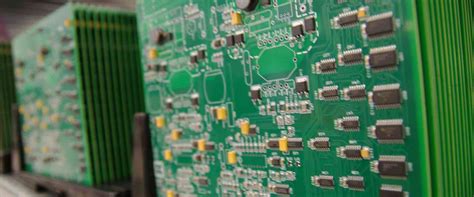
Key Players in the Automotive PCB Manufacturing Industry
In the rapidly evolving landscape of the automotive sector, automotive PCB manufacturers play a pivotal role in pushing the boundaries of technology. Notable companies in this industry are at the forefront of developing advanced printed circuit boards (PCBs) that serve as critical components in modern vehicles. These manufacturers utilize innovative pcb assembly techniques to enhance the efficiency and functionality of electronic systems within cars. By creating high-quality pcba products, they enable sophisticated features such as autonomous driving systems, advanced safety protocols, and enhanced entertainment functionalities. Key players are not only focusing on meeting current demands but are also spearheading research into next-generation materials and designs that emphasize durability and performance. Their contributions have significantly improved vehicle reliability, reduced weight, and optimized space utilization within automotive designs. Moreover, these manufacturers are continually investing in sustainable practices, ensuring that their production processes align with environmental standards while meeting the growing demand for electric vehicles. The collaboration between leading automotive companies and these PCB specialists fosters an environment of innovation that underscores their importance in shaping the future of vehicle technology.
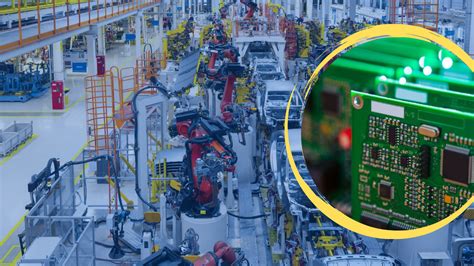
Innovative Technologies Shaping Modern Automotive PCBs
The automotive industry is witnessing a significant transformation due to the integration of innovative technologies in PCB assembly processes. As vehicles become more sophisticated with the advent of electric and autonomous driving technologies, the design and manufacturing of printed circuit boards (PCBs) have evolved to meet these new demands. Advanced techniques such as multi-layer PCBs, which allow for more complex circuits in a compact form factor, are gaining traction. Additionally, the use of flexible PCBs enables greater design freedom and helps to reduce space and weight in automotive applications. These innovations not only enhance the aesthetic appeal of vehicle interiors but also lead to increased reliability and performance in vehicle operations.
Furthermore, emerging technologies such as 3D printing are revolutionizing the way PCBs are produced, enabling manufacturers to create prototypes rapidly for testing and refinement. This responsiveness fosters a more agile manufacturing environment where changes can be implemented quickly to adapt to market needs or new safety standards. The heightened focus on sustainability also drives manufacturers toward eco-friendly materials and processes that minimize waste during pcba production.
“Embracing cutting-edge technology creates opportunities for automakers to improve both safety features and user experience in modern vehicles,” highlights a leading industry expert.
As the demand for smarter vehicles increases, these technological advancements pave the way for developing highly efficient automotive systems that promise not only enhanced performance but also greater safety for all road users. The ongoing evolution in PCB manufacturing is pivotal in shaping how future vehicles will communicate, function, and interact with their environments.
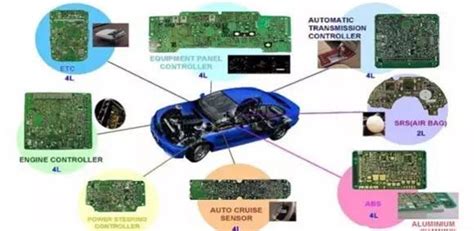
How PCBs Enhance Vehicle Performance and Safety
The integration of Printed Circuit Boards (PCBs) into automotive systems plays a pivotal role in enhancing vehicle performance and safety features. Modern vehicles rely heavily on pcb assembly to create compact, efficient, and reliable electronic frameworks that control various functions, from engine management systems to advanced driver-assistance systems (ADAS). The evolution of automotive PCBA has led to the miniaturization of components, resulting in lighter weight designs that contribute to fuel efficiency. Moreover, the robustness of these circuits ensures that critical safety features operate seamlessly. For instance, real-time data from sensors connected through PCBs facilitates timely responses in emergency situations, significantly reducing response times. Furthermore, these circuit boards support sophisticated software algorithms that analyze driving conditions and user behavior, paving the way for innovations such as autonomous driving technologies. By consistently adapting and improving their PCB assembly techniques, manufacturers focus on enhancing the reliability and durability of automotive electronics, ultimately creating safer driving environments for consumers.
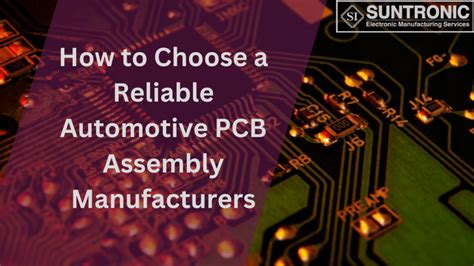
Future Trends in Automotive PCB Design and Manufacturing
The automotive industry is on the cusp of transformative changes, particularly in PCB design and manufacturing. As vehicles become more reliant on advanced electronics, pcb assembly processes are evolving to accommodate more complex circuits and functionalities. Future trends indicate a significant shift towards the miniaturization of components, allowing for more compact designs that contribute to better space management within vehicles. This trend is complemented by innovations in materials science, as manufacturers explore new substrates that offer improved thermal management and performance durability. Moreover, the move towards electric vehicles (EVs) necessitates PCBA solutions that address higher energy efficiency and enhanced battery management systems. As automakers focus on integrating autonomous driving technology, the demand for *high-frequency* PCBs to support communications systems will surge. Additionally, automation in production processes will optimize efficiency and reduce lead times, allowing for more agile responses to market demands. Collectively, these trends underscore a robust evolution towards safer, more reliable, and technologically advanced vehicles driven by cutting-edge automotive PCB** solutions.
Case Studies: Successful Collaborations Between Automakers and PCB Manufacturers
In the rapidly evolving automotive industry, the synergy between automakers and PCB manufacturers has led to significant advancements in vehicle technology. One notable example is the collaboration between a leading automobile manufacturer and a specialized pcb assembly firm. By integrating state-of-the-art pcba technologies, they were able to enhance driver assistance systems and streamline vehicle communication networks. This partnership not only resulted in increased safety features but also improved overall vehicle reliability.
Another case study highlights a prominent electric vehicle manufacturer working closely with a PCB manufacturer renowned for its innovative designs. Together, they developed compact and efficient circuit boards that optimize battery management systems, ultimately extending vehicle range and performance. The successful implementation of these advanced PCBs underscores the critical role of these partnerships in driving innovation.
Furthermore, a recent collaboration aimed at reducing production costs showcased how automakers can leverage the expertise of PCB manufacturers to achieve sustainability goals. By adopting more environmentally friendly materials during the pcb assembly process, they significantly decreased their carbon footprint while maintaining high-quality standards.
These examples illustrate how successful collaborations between automakers and PCB manufacturers are reshaping the future of automotive technology. The integration of advanced circuitry not only enhances vehicle performance but also ensures safety and pushes the boundaries of what is technologically possible in modern automobiles.
Environmental Considerations in Automotive PCB Production
In recent years, environmental considerations have become increasingly significant in the production of automotive PCBs (Printed Circuit Boards). As the automotive industry shifts towards sustainability, manufacturers are actively researching methods to reduce waste and improve energy efficiency during the pcb assembly process. This includes utilizing eco-friendly materials that lower the environmental impact without compromising on performance. Manufacturers are exploring innovations in pcba technology that incorporate recyclable substances, thus allowing for easier recycling at the end of a vehicle’s life cycle. Moreover, implementing clean energy solutions in manufacturing facilities has gained traction, further mitigating pollution and carbon footprints. The push towards compliance with stringent environmental regulations is not just a response to global demands; it also aligns with consumer preferences for greener technologies. In essence, by integrating sustainable practices in PCB production, manufacturers not only enhance vehicle performance and safety but also contribute to a more sustainable future for the automotive industry as a whole.
The Role of Research and Development in Advancing Automotive PCB Solutions
In the ever-evolving landscape of automotive technology, research and development (R&D) play a pivotal role in the advancement of automotive PCBs. The growing complexity of modern vehicles demands that manufacturers engage in continuous innovation to enhance PCB assembly processes. Through R&D, companies can develop advanced routing techniques, utilize high-density interconnects, and adopt materials that optimize thermal management within PCB designs. For instance, efforts to improve the reliability of PCBA (printed circuit board assembly) directly contribute to enhancing vehicle safety systems and overall performance. As R&D initiatives focus on integrating functionalities such as vehicle-to-vehicle communication and smart sensor technologies, the role of PCB manufacturers becomes increasingly critical. By investing in cutting-edge research, these companies can not only address current industry challenges but also anticipate future demands, ensuring that vehicles remain competitive in a rapidly changing market. This forward-thinking approach to R&D ultimately serves as a catalyst for developing innovative solutions that propel automotive technology towards safer and more efficient horizons.
Conclusion
In summary, the automotive industry continues to experience significant advancements, largely driven by the innovative efforts of leading automotive PCB manufacturers. These companies have been pivotal in integrating PCB assembly into modern vehicles, thereby enhancing both functionality and reliability. The role of pcba has evolved from mere connectivity to becoming a fundamental component in ensuring optimal vehicle performance and safety. By harnessing cutting-edge technologies such as multilayer boards, flexible circuitry, and advanced material science, these manufacturers are setting new benchmarks in quality and efficiency. As vehicles incorporate more complex electronic systems, the demand for high-quality PCBs becomes ever more critical. The collaboration between automakers and PCB manufacturers has resulted in not only improved vehicle designs but also the implementation of eco-friendly practices in production processes. Looking ahead, the synergy between automotive PCBs and evolving automotive technologies promises to drive further innovations that will likely transform transportation as we know it today.
FAQs
What is the significance of PCBs in automotive applications?
Printed Circuit Boards (PCBs) are vital in automotive applications as they enable the integration of complex electronic circuits, enhancing vehicle functionality, performance, and safety. They facilitate reliable communication between various electronic systems in the vehicle.
How does pcb assembly contribute to vehicle safety?
A robust pcb assembly ensures that automotive electronics function correctly and efficiently. This minimizes the risk of failures in critical systems, such as braking and steering, ultimately enhancing passenger safety.
What innovations are being introduced by leading automotive PCB manufacturers?
Leading automotive PCB manufacturers are adopting advanced technologies such as flexible PCBs, multilayer designs, and improved materials that enhance durability, thermal management, and performance under diverse conditions.
How do PCBAs improve overall vehicle performance?
By utilizing sophisticated PCBA, manufacturers can create more compact designs that save space and weight while delivering higher functionality. This leads to improved fuel efficiency and better overall performance of the vehicle.
What role does R&D play in advancing automotive PCB technology?
Research and development are crucial in driving innovations in automotive PCB technology, allowing manufacturers to explore new materials, design methodologies, and applications that can meet evolving industry standards and consumer demands.

